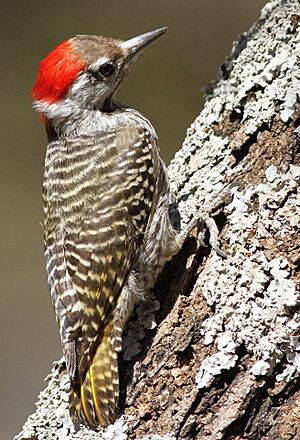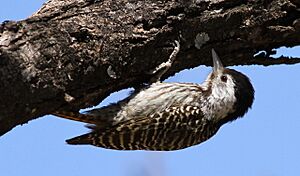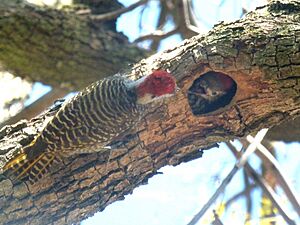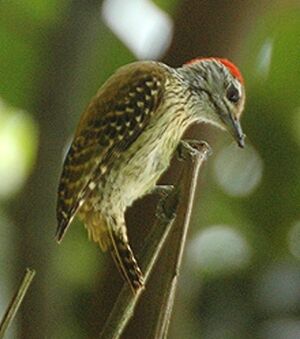Cardinal woodpecker facts for kids
Quick facts for kids Cardinal woodpecker |
|
|---|---|
 |
|
| Conservation status | |
| Scientific classification | |
| Genus: |
Dendropicos
|
| Species: |
fuscescens
|
| Synonyms | |
|
|
The cardinal woodpecker (Dendropicos fuscescens) is a small bird found all over sub-Saharan Africa. It lives in many different places, from thick forests to thorny bushes. You can often hear its loud calls, which help identify it. Male and female cardinal woodpeckers look a little different, especially on their heads.
Contents
About Its Name
The cardinal woodpecker was first officially described in 1818. A French bird expert named Louis Pierre Vieillot gave it the scientific name Picus fuscescens.
Later, this woodpecker and 11 others from Africa were put into a group called Dendropicos. This name was created by another French expert, Alfred Malherbe, in 1849. The word Dendropicos comes from old Greek words. Dendron means tree, and pikos means woodpecker. The second part of its name, fuscescens, is a modern Latin word meaning "blackish".
There are nine different types, or subspecies, of the cardinal woodpecker:
- D. f. lafresnayi Malherbe, 1849 – Found from Senegal to Nigeria.
- D. f. sharpii Oustalet, 1879 – Found from Cameroon to northern Angola.
- D. f. lepidus (Cabanis & Heine, 1863) – Found from south Sudan to northwestern Tanzania.
- D. f. hemprichii Ehrenberg, 1833 – Found in lower areas of Ethiopia to Somalia and Kenya.
- D. f. massaicus Neumann, 1900 – Found in middle areas of Ethiopia to Kenya and Tanzania.
- D. f. loandae Grant, CHB, 1915 – Found from Angola to west Tanzania, Zambia, and parts of southern Africa.
- D. f. hartlaubii Malherbe, 1849 – Found from southern Kenya to central Mozambique.
- D. f. intermedius Roberts, 1924 – Found from central Mozambique to eastern South Africa.
- D. f. fuscescens (Vieillot, 1818) – Found in southern Africa.
What It Looks Like
Like other woodpeckers, this bird has a straight, pointy beak. It also has a stiff tail that helps it lean against tree trunks. Its feet are special, with two toes pointing forward and two pointing backward. This helps it grip trees. It has a long tongue that can shoot out to catch insects.
The cardinal woodpecker is a very small bird. It is about 14 to 15 cm (5.5 to 5.9 in) long from its beak to its tail. Its back is a dull olive color with lighter dots and stripes. Its belly is white with many black streaks. The feathers near its tail are a brownish-yellow.
Its white throat and face have a clear black stripe across them. The top of its head is olive-brown. The head pattern changes depending on the bird's age and whether it is male or female.
- The male has a red back of the head and neck.
- The female has a dark back of the head and a black neck.
- Young males have a red back of the head and a black neck.
When the bird is excited, it can raise its small group of feathers on its head, called a crest.
Where It Lives
The cardinal woodpecker lives in tropical parts of western and central Africa. Its home range is very large. It includes countries like Angola, Kenya, South Africa, and many others across the continent. You can find it in many different places. These include thick forests and areas with thorny bushes.
How It Behaves
Cardinal woodpeckers often live in small family groups. Sometimes, they join small groups of different bird species. They usually look for food in the lower parts of trees, among bushes and vines. They also search on maize stalks and reeds.
They peck quickly and poke into thick plants. They climb along small branches and even hang upside down. Like other woodpeckers, they eat insects. These birds are often seen and make soft drumming sounds. Their call is a high-pitched krrrek-krrrek-krrrek.
They make their nests in holes in trees. They don't line the nest with anything soft, just wood chips.
Raising Young
Cardinal woodpeckers usually breed in spring or early summer. Like other woodpeckers, they dig a new nest hole each year. This usually takes a few weeks. They do not build their new nest near the old one. The entrance hole to the nest is oval-shaped and is about 2 meters (6.5 feet) off the ground.
They lay 1 to 3 shiny white eggs. The eggs are laid one day apart, and the parents start sitting on them right away. Both the mother and father bird help to incubate the eggs. They also take turns feeding the chicks. The eggs hatch in about 12 days. The young birds leave the nest in about 27 days. After leaving the nest, the parents continue to care for their young for another 8 to 10 weeks.
Its Conservation Status
The cardinal woodpecker lives in a very large area. It is common in most of the places where it lives. There are no major threats to this bird that we know of. Because of this, the IUCN says its conservation status is "least concern". This means it is not currently in danger of disappearing.






